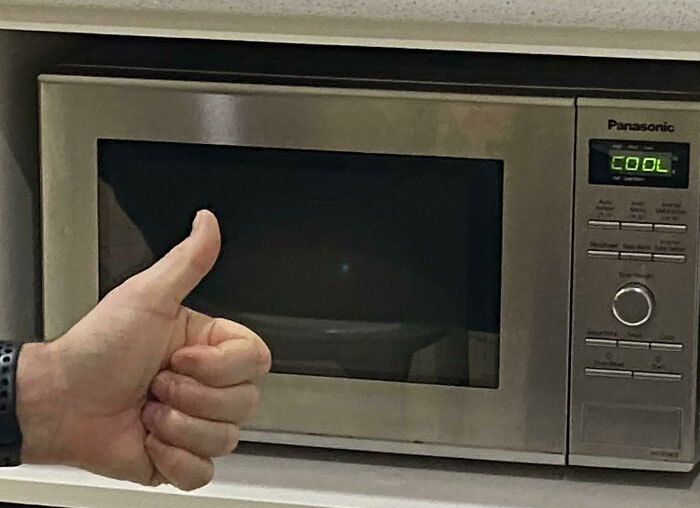deleted by creator
I know you’re joking but presumably this is so the distributor or restaurant can scan the whole wheel with an NFC reader or whatever before using it.
How the fuck do you counterfeit cheese? Do you use chocolate milk instead of regular?
The designation “Parmigiano Reggiano” is a protected designation of origin (PDO) in the European Union.
It means that to be able to call a cheese “Parmigiano Reggiano” a producer needs to follow a strict set of rules on how to produce the cheese, how to mature it, how the cows are being fed and it has to be manufactured in a specific area in Italy.
So if someone is making cheese without following the rules and sell it as Parmigiano it would be counterfeit cheese. Just like someone selling lemonade but calling it “Sprite”.
And don’t forget the “origin” part. These designations also include being made in a specific region. You could follow all the rules and exact ingredients for Champagne, but if it’s not made in Champagne, France then you can’t call it Champagne. Same for Cognac, etc.
if it’s not made in Champagne, France then you can’t call it Champagne
Except for some wineries in the Napa Valley in California. https://vinepair.com/wine-blog/loophole-california-champagne-legal/
Those European rules don’t apply in the US. You can also make parmigiano reggiano in the US.
Europeans definitely try to enforce rules like this worldwide, and AFAIK they’re mostly successful, at least in developed nations.
I haven’t seen illegitimate Parmagiano Reggiano in the USA. They usually just refer to the US-made version as “parmesan”. I also live relatively close to Napa Valley and pretty much nobody here calls wine Champagne unless it’s actual Champagne, other than a few companies that still use that loophole I linked to.
If its made in the US is parmeesian
True, you don’t see producers selling fake “parmigiano reggiano” in the US (why bother when most Americans only know it as parmesan anyway). But the EU couldn’t stop them. It’d more likely be a matter for US regulators if they consider it deceptive.
You can also make parmigiano reggiano in the US.
I thought parmigiano reggiano was also a protected term/origin in the US. Like Vidalia onions are. Most of the other EU ones aren’t though.
That’s why “parmesan” is a thing - it’s a cheese similar to parmigiano reggiano, but with a shorter minimum aging time, and no requirements on where it’s made or what the cows are fed - parmesan can be made with commodity milk anywhere rather than in one part of Italy from a specific breed of cattle fed at least 50% by grass grown in that part of Italy. Other than the aging time the process is similar, which is why the cheese is similar.
This isn’t entirely true, according the article. If a producer in the US was using the name “Champagne” before 2005, they can continue to do so, but producers can’t start using it anymore.
It took two decades of negotiations, but finally, in 2005, the U.S. and the EU reached an agreement. In exchange for easing trade restrictions on wine, the American government agreed that California Champagne, Chablis, Sherry and a half-dozen other ‘semi-generic’ names would no longer appear on domestic wine labels – that is unless a producer was already using one of those names.
That’s why I said “some wineries” :)
I’m as territorial and proud of what is made in my country as the next dude but the lengths taken to protect some products, especially by french and italian are ridiculous.
I kind of like it, because it becomes a small club where all members know each other and control each other. The product price is directly linked to the quality of the product, so all producers have a vested interest in controlling their neighboring producer.
It also makes sense for agricultural products, where certain climate and earth composition influence the outcome a lot
Off the top of my head I can name three products unique to my country which we made sure to DOP (Protected Origin Denomination). These are:
Vinho do Porto (Port Wine)
Queijo Serra da Estrela (Serra da Estrela Cheese) This is a cheese made from sheeps milk, that is specially made using a plant extract for curdling and has to be buttery in consistency; if solid, by aging, it needs to be hard as a rock yet brittle when cut
Queijo S. Jorge (Saint Jorge Cheese) this one is essentially our version of parmesan cheese, very hard and salty, aged a minimum of 6 months to years
Every single one of these products is unique, as it has specific production techniques and quality parameters that need to be observed and need to be manufactured in specific regions in order to receive the DOP seal yet we knock off these products ourselves.
There is no need for a specific producer to protect their product with complex and sophisticated techniques like the one in the post because rules are established in seat of law and the seal obtention follows very strict proceedings and regular inspections and quality control.
The knock offs are often manufactured by DOP producers. The end product is similar if not the same as the DOP but fails to observe some minute parameter, like not using a specific milk or variety of grape, with no loss of quality to the end consumer and often at the same price.
Counterfeiting these products is a crime but between the specific and controlled labels, it is just not worth the hassle. And internationally, it is even less worth it. South Africa knocks off Port Wine, produced by descendants of portuguese there; we sat down with their Chamber of Commerce and agreed they could call it Port like or Port style but not Port: they sell theirs, using our tradition and reputation, and cross advertise the original.
Everybody wins.
Same for Lambic. For cheese and alcohol the region is important. All of these products have micro cultures or yeast in them. For Lambic, it’s a naturally occurring yeast. If they allow other beers to be produced in that region, then the commercial yeasts will dominate the natural Lambic yeasts in the finished product, and you will end up with a different end result. So the regional specification is a quality control method to ensure you get the exact same microbiology as has been used for hundreds of years.
Just like someone selling lemonade but calling it “Sprite”.
In Australia, we actually do use “lemonade” to refer to drinks like Sprite, lol. We don’t really have the American-style non-carbonated lemonade.
You got it backwards. He meant that it’s the same as selling lemonade while trying to pass it as Sprite because of the branding.
It’s because the use of the name parmigiano reggiano requires that the cheese come from a certain region of Italy (or somewhere in Europe). There’s nothing else special about it. Counterfeit cheese in this case is just the same exact cheese but made elsewhere and likely sold for cheaper.
Source: I work in cheese and also Wikipedia several months back
I’m picturing you as an average office worker, but with a Willy Wonka-esque boss who has replaced all of the furniture with various types of dairy products.
Oh they work ‘in’ cheese, people always misunderstand and think they work in the cheese industry but their office is just often coated in cheese
Did he say “Blessed are the cheesemakers?”
That’s not exactly true. If you make parmigiano you have to follow pretty strict manufacturing procedures to ensure that the cheeses have the same taste.
It’s pretty much the same thing as a brand except it’s not produced by one structure but several independent structures. The main advantage is that you know what you are getting.
In this case you may be right, but region protected products can be quite ridiculous. For example Bourbon:
- Produced in the U.S. and its Territories (Puerto Rico), as well as the District of Columbia
- Made from a grain mixture that is at least 51% corn
- Aged in new, charred oak containers
- Distilled to no more than 160 (U.S.) proof (80% alcohol by volume)
- Entered into the container for aging at no more than 125 proof (62.5% alcohol by volume)
- Bottled (like other whiskeys) at 80 proof or more (40% alcohol by volume)
(Source Wikipedia)
That’s pretty fucking generic except for the made in USA portion. If I’m not mistaken Champagne has similarly silly restrictions with no significant difference.
Cheese bro.
Another way is by cutting the cheese, heh, with fillers like sawdust.
You steal the bacteria. Each breed of it makes different cheese.
deleted by creator
How is a microchip edible? Big as a sand grain? How does it work? How long has this tech existed? How many microchips have I eaten? Do they stop working if I eat them?
It’s not edible. The chip is in the packaging. Chipping packaging is normal and the headline is funny but sensational
Now producers have been trialling the most modern of authentication methods – microtransponders about the size of a grain of salt inserted into the labels found on the rind of 120,000 wheels of parmigiano reggiano.
Edit or it might as well be edible no one knows since no ones eaten cheese with the packaging
That’s not in the packaging, it’s in the rind of the cheese itself. The labels are also written on the cheese itself.
I’m willing to bet some people on this planet have eaten the packaging at least once.
into the labels found on the rind
The labels are directly on the rind of the cheese - not on a sticker or something.
Still in the rind. Chances of eating it unless you specifically want to eat it are nill
Lots of people throw the rind in stews and sauces. It adds umami. So now I gotta fish out the bay leaf and a microchip.
Mmm… lead soldering flavor
its probably a rfid like thing made with metals that will just pass through you
If a tiny chip is embedded in glass or a similar biologically inert coating, and it’s still small enough to pass your intestines without noticing, then it’s edible. RFID can be very small, has no internal power, and only responds to a nearby request ping, which also gives it a few milliseconds of power.
I knew it! It was big cheese all along.
Big pharma was just a ruse!
Big Parma
h
r
a
I’m not ok with big pharma putting chips in me.
I’m totally ok with Big Parma putting chips in me so I can get more parm.
If you’ve ever actually cooked with authentic parmigiano reggiano you would understand why. It’s absolutely fantastic stuff.
I used to cook with just whatever old cheddar was on sale at the big box stores. Then my father bought me a couple wedges of authentic parmesan and pecorino romano for my birthday. I will never go back. It’s not even comparable. I always have them on hand now.
You’re comparing cheddar to parmigiano. Those are two completely different styles of cheeses. Try the same recipe with a parmigiano and a grana padano, and it will be much closer, and you very well may appreciate the difference in price between the two.
Implying that all cheeses of the same type are roughly equal is insanity if you actually cook. Even between different producers of the same region in the same country you can get wildly different texture, humidity, flavor, behavior when heated, etc.
That wasn’t the implication I was trying to make. I was saying that if you’re used to cooking with cheddar, you don’t replace it with parmigiano, and vice versa. They don’t serve the same purpose in cooking. If you’re cooking carbonara with cheddar, you’re obviously going to be disappointed in the result. If you cook a carbonara with grana padano instead of parmigiano, you’re like 90% of the way there, and most people won’t know the difference. They’re not equivalent but they’re similar.
Cooking cheese makes it lose a lot of taste. If you really want to appreciate the specificities of cheese, you should eat it raw. Also don’t forget to take it out of the fridge 30 min before so the fat is not cold and carries more flavor.
I think you’re understating the difference between cheap Cheddar and authentic Parma.
It’s like when the recipe calls for a glass of dry white wine, but the person exchanges it for Colt 45 malt liquor and thinks the recipe was the problem.
I understand that those are completely different but most people don’t buy authentic Parmigiano, pecorino romano or grana padano(I need to try this one). They use the regular plain cheese you buy in the big box stores. So to the average person putting a micro chip in a cheese wheel (which I read wasn’t even true) is an absurd notion. But I was pointing out that the regular cheddar/mozzarella the average person buys is bland garbage compared to these cheeses. I think people should try them and they will realize why they care so much about its authenticity.
You might as well say that “Hamburger patties are bland garbage compared to pickles”
Softer cheeses like mozzarella and cheddar have a totally different job than hard cheeses like Romano and Parmesan. Mozzarella and cheddar provide body, texture, a neutral flavor, and lots of calories. Romano and Parmesan provide only flavor, and can be used to complement - not replace - the milder soft cheeses
This poster seems to just be saying if you’ve had cheap regular cheese you are amazed when you have legit authentic cheeses like these. A lot of the cheese people buy, in the US at least, is just some basic shit often called ‘cheddar’ or whatever but not truly authentic cheddar or mozzarella.
They can be used to replace, I just put less. Not sure why you would say that. You don’t use a soft cheese when you make authentic Carbonara.
Good point, I guess I mean it’s not a 1-to-1 replacement
I agree that people should try them, and they are superior to cheap, mass-produced supermarket cheeses. But even a cheaper imitation parmigiano (I’m not talking about the powdered “cheese” you get in a Kraft bottle) is close enough to “certified” stuff that if you want to save some money, you can approximate it with something nearly equivalent for half the price. And if you don’t have an especially sensitive palate, you may not even be able to tell the difference.
I always buy what in my country is typically called “Italian Hard Cheese” for legal reasons. It’s as you say, a very close approximation to the real thing if you’re not too discerning. Main reason for me is that I don’t like parmigiano’s insistence on using rennet from calves.
I’m sure that’s true. I’ve never had the imitation stuff so I don’t know how they compare. I’ve just been blown away by how good they are that it justifies the price for me. They are very strong cheeses so you don’t need to use much. I vacuum seal them after every use so they last forever.
On a semi-related note, Guanciale is ridiculously expensive and that I can’t justify buying no matter how much I want to make authentic Carbonara.
Mmmmmmmmmmmm
Cheese
This is the kind of culinary finesse I’m on the level of in this thread.
Food taste good me like
Food taste icky me no eat
I mean I’m not surprised by it at all. Olive oil is a huge market for fakes, cheese is even more lucrative
deleted by creator
Cheddar tastes nothing like parmigiano. They’re completely different cheeses, and it’s a pointless comparison using them in the same recipe.
Try it and you’ll see!
It has so much more flavor! I’ve cooked dishes that I’ve made dozens of times and the only thing I changed was the cheese used. Those dishes tasted better every single time. It’s hard to describe because I also thought that it wouldn’t make much of a difference. But when I tried it, I was blown away.
I’ll never be able to explain it through a comment. I would recommend that everyone at least try it. You can usually find a small wedge of it at some grocery stores, shouldn’t be too expensive. Then make a dish that you’ve made many times but use those cheeses instead. You will see the difference right away.
“Instead”? I’ll be honest man, comparing parmigiano reggiano to cheddar is like comparing dinner rolls to donuts. If switching improved your food, it was user-error, not the cheese
What are you even saying. They are both cheese. Take macaroni and cheese for example. Most boxed macaroni and cheese uses cheddar and so do many people when they make it themselves.
But I’ve made it with a combination of Parmigiano and pecorino romano and it was fantastic. Much better than when I made it with cheddar. Same thing with scalloped potatoes, made them with cheddar many times but they were never as good as when I made them with the Italian cheese.
Not sure what point you are trying to prove?
I do Parmesan Romano gnocchi pretty often, and you’re right, it’s delicious! I didn’t mean to imply that hard cheeses can never replace soft ones, just that it’s not a 1-to-1 substitution. I don’t recall ever eating a real pizza without mozzarella, and good cheddar is amazing in it’s own right. Basically, I’m just disagreeing with you that mozzarella and cheddar are “bland garbage”, because it’s all how you use them.
I agree that cheddar is not bland garbage. I was just trying to make a point of how vastly different the flavors between the two were. I’ve had 4 year aged cheddar and it is fantastic. I guess I was mostly comparing the authentic high quality cheeses to low end mass produced crap. Not really a Parmigiano vs cheddar thing I guess. I’m sorry if I gave that impression.
Also, that’s a great idea. I have some homemade gnocchi in my freezer, I should try it with Parmigiano and pecorino.
Betcha can’t eat just 1 microchip
https://youtu.be/0FELnrRVIUc?si=EmuJdm0qMNkmz-JE?=10 Ok but there’s only one microchip per 10,000 calorie cheese wheel. Odds are only one family member per holiday bites a chip.
Here is an alternative Piped link(s):
https://piped.video/0FELnrRVIUc?si=EmuJdm0qMNkmz-JE?=10
Piped is a privacy-respecting open-source alternative frontend to YouTube.
I’m open-source; check me out at GitHub.
Wtf?
The Egyptian mystery poster got me.
It’s an illuminati conspiracy in a cookie commercial
Edible microchips, my favorite kind of microchips
Combine it with fish to get fish and chips
Plot twist: the chip gets stuck in an intestinal fold and Big Parma thugs beat the shit out of you.
They aren’t allowed to. You become authentic Parmesan cheese
Wouldn’t the counterfeit be better than the original at this point?
Che cazzo è questa merda
How the hell do you make an edible microchip
You make a microchip, and then you just tell people it’s edible, simple.
deleted by creator
Did anyone get past the pay-wall to see the suppliers/brands?


















